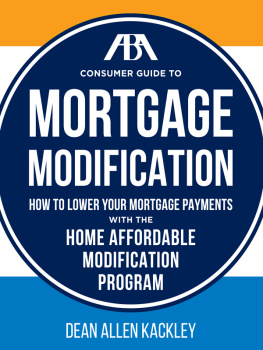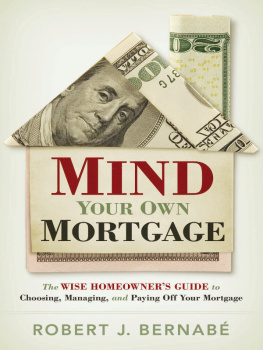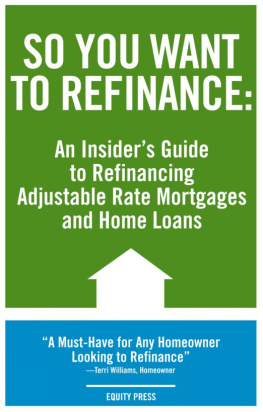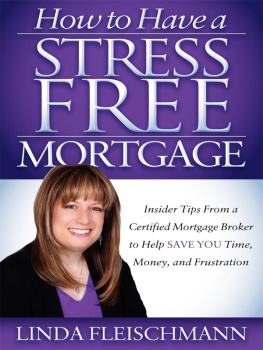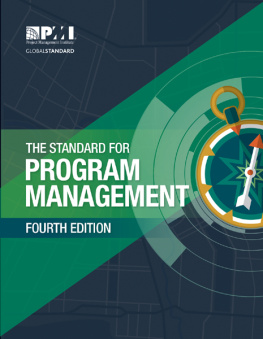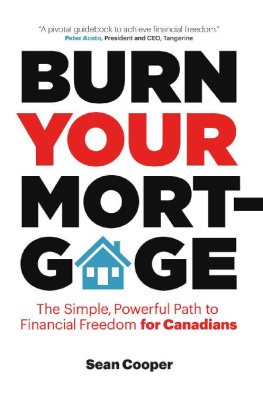
CONSUMER GUIDE TO
MORTGAGE MODIFICATION
HOW TO LOWER YOUR MORTGAGE PAYMENTS WITH
THE HOME AFFORDABLE MODIFICATION PROGRAM
DEAN ALLEN KACKLEY

For Susan Carrington
Ultimately, my desire is to help resolve the residential mortgage debacle and restore peace of mind to millions of American familiesone borrower at a time.
Dean Kackley
Contents
Preface
Mortgage problems? This book will help. Its the consumers version of federal rules for modifying home loans.
If you dont know what to do. If youve applied for a modification, but its taking too long. If youve received a modification but still cant make your payments. Even if youve been turned down. Rely on this valuable resource during a long, unfamiliar, and discouraging process. It can shift the balance of power and help you get control.
Cut through technical jargon and specialized knowledge. Homeowners, landlords, and their trusted advisors now have a simple and complete reference when working with lenders. Step by step, it explains what you need to know and do to get a loan modification.
Making Home Affordable (MHA) was launched in February 2009 as part of the Obama Administrations comprehensive approach to help homeowners avoid foreclosure, according to the U.S. Department of Treasury, which runs the program. Its Home Affordable Modification Program (HAMP) sets rules for more than 85 percent of all home loans. You ask: What are the rules? Can I lower my payments? Is my lender required to modify my loan? Do I qualify? Does my lender play by the rules? Here are the answers to your questions, plus 12 questions to ask your lender.
Now you can understand the guidelines that the big lenders like Bank of America, Chase, Citi, Ocwen, and Wells Fargo use to modify home loans. They claim they want to help. It doesnt matterthey are overwhelmed, and they work for somebody else. Borrowers must take responsibility for themselves. This book makes that possible.
The ABA Consumer Guide to Mortgage Modification includes helpful suggestions and practical tools. Use the forms, grids, and worksheets to calculate your new payment, complete financial information, and qualify for a modification. Look up unfamiliar but crucial terms in the glossary.
This is the users manual for homeowners, landlords, and their professional advisors to get the most out of HAMP. Knowledge is power. Get the results you want and deserve.
Introduction
If you cant afford your mortgage payment or your loan balance is more than the value of your property, help is available.
The federal Making Home Affordable (MHA) program started in April 2009 with a simple, some might say naive, premise: modify problem loans so payments are affordable and sustainable for financially distressed homeowners. Five years later, though, less than a third of those thought to need help actually received it, as slightly more than a million modifications have barely scratched the surface.
In June 2012, the program expanded exponentially to include landlords and rental properties and guidelines so complex as to leave the average property owner dazed and confused. Later, program expiration was extended to the end of 2015, but the problem will be around for at least another decade.
The program works through lenders to help homeowners and owners of residential rental properties avoid foreclosure. The centerpiece of MHA mortgage relief is the Home Affordable Modification Program (HAMP). Written for lenders, loan servicers, and mortgage investors, the guidelines would overwhelm most borrowers with technical jargon, specialized knowledge, and sheer density. This book is the consumers version for borrowers and their trusted advisors, a simplified but complete resource to use when working with lenders.
HAMP consolidates best practices and institutional thinking to establish an industry-wide standard for loan modification, which is the priority and starting point for other MHA foreclosure alternatives. Guidelines instruct lenders how to identify at risk homeowners and how to modify their home mortgages so monthly payments will be affordable and sustainable. Recent revisions now include owners of rental properties and homeowners previously declined for HAMP modifications.
The purpose of this book is to level the playing field, to identify eligible borrowers, and to help them modify their loans. It explains technical terms, concepts, and procedures in useful and usable ways. It is currentcrucial because the state of mortgage modifications changed entirely with HAMP, and then changed again in June 2012, with periodic refinements. Earlier information is out of date.
An essential ingredient of this book is my actual current work with HAMP, supplemented by personal knowledge and experience. I am an attorney and real estate broker. I counsel clients regarding distressed mortgages and loan workouts with lenders and loan servicers, saving tens of thousands of dollars in payments and hundreds of thousands of dollars in principal reductions.
Facing the Problem
Relying on the generosity of banks to solve the problem hasnt worked. Just to get their attention has taken new state consumer protection laws, federal Wall Street reform legislation, formation of the Consumer Financial Protection Board, and the U.S. Department of Justice supported by 49 states attorneys general. Its the same mistake we made when we relied on banks to lend responsibly in the first place. Homeowners in distress need to get educated. Then, instead of leaning on banks, they can stand up or push back when needed.
While the situation according to the U.S. Department of Treasury and my own observation has improved, heres the magnitude of the problem:
- Value of equity lost by homeowners$171 billion. This is not lost property value. Its only the portion (equity) lost by the homeowner, which amounts to everything before the loan goes underwater.
- Underwater home mortgages11 million. Thats 11 million homeowners with no equity hoping desperately for their homes to float on rising fair market values. On the contrary, in the foreseeable future, these are short sales or foreclosures waiting to happen.
- Foreclosure salesabout 60,000 per month. Thats three-quarters of a million homes lost in a year, vastly more of which go to lenders than to private buyers.
- Sales by lenders of properties received in foreclosureabout 50,000 per month. This number was higher a year ago but now has fallen below the number of foreclosure sales. The result increases the institutional (shadow) inventory of unsold properties.
- Short salesabout 25,000 per month. At this rate, it would take 36 years to sell the 11 million homes with underwater mortgages.
- Modificationsof the 2.18 million trial modifications started through early 2014, only 1.35 million (62 percent) became permanent and fewer than a million (43 percent) are still active.
According to government estimates, three million to four million American families can benefit from loan modifications. In fact, the number probably approaches twice that many, and now countless owners of residential rental properties have been added. Whatever the total, many millions of Americans suffer daily from fear, confusion, discouragement, and shame. A large fraction lives under the dark cloud of foreclosure and loss of homemore than 10 million foreclosure filings during 2009 through 2013. Further aggravating the problem, accumulated stress jeopardizes health, family, productivity, and self-esteem. The human cost is staggering.

